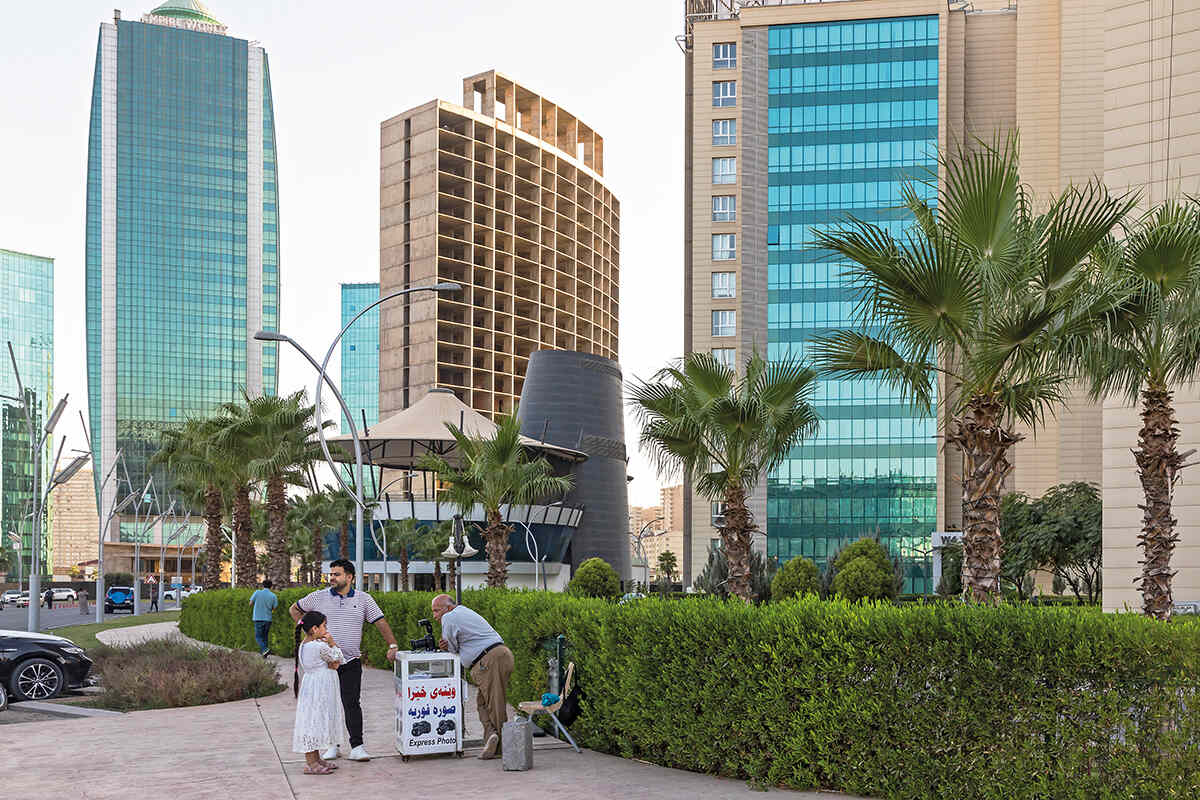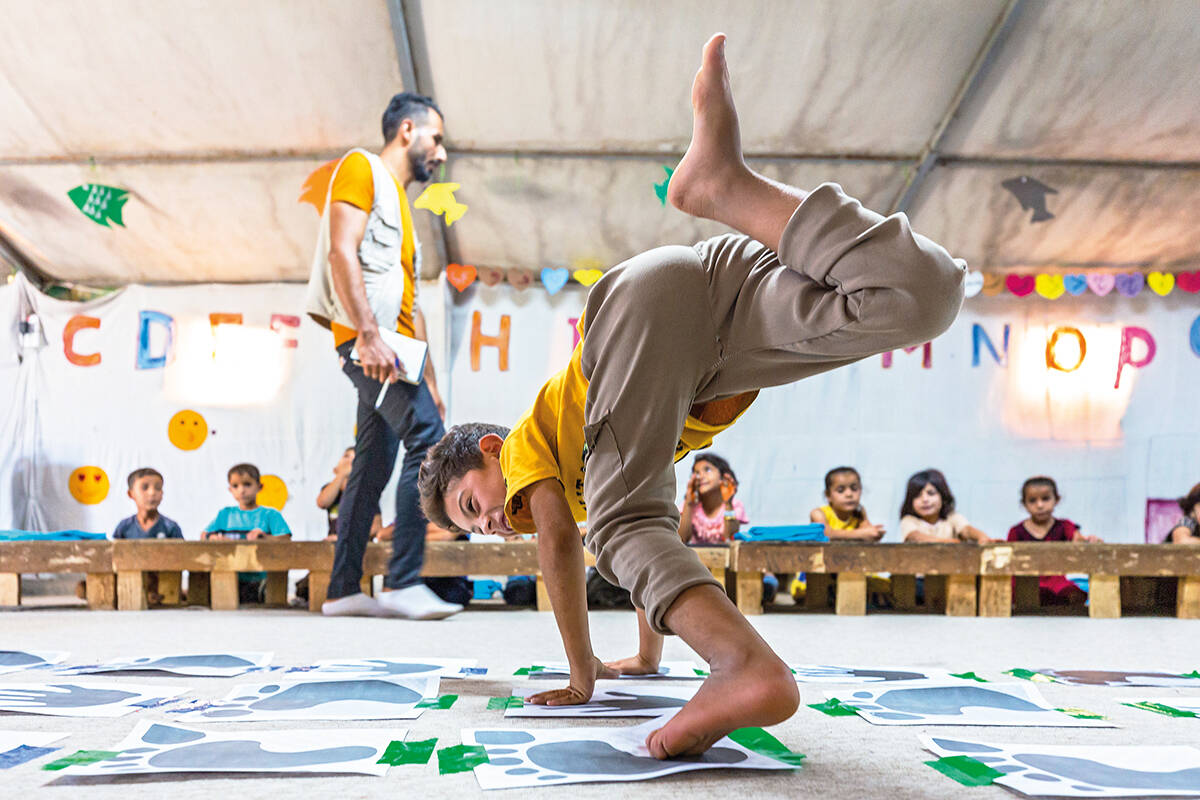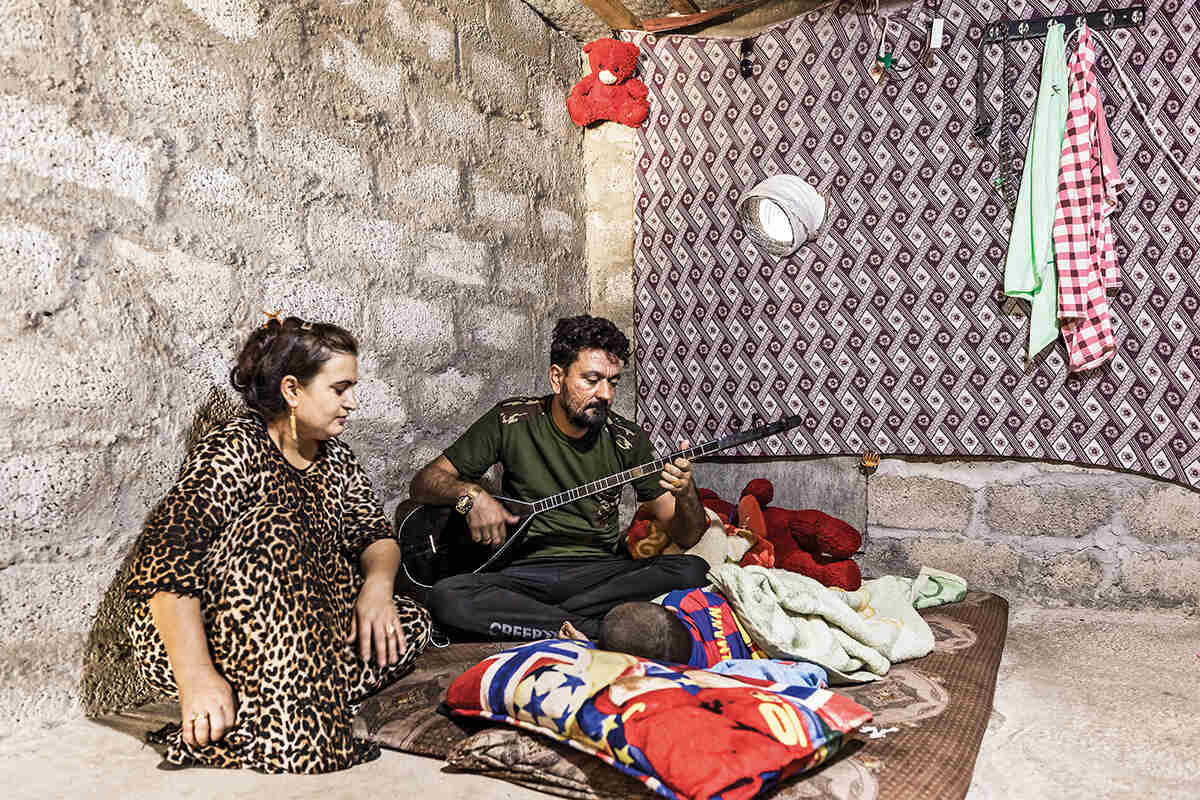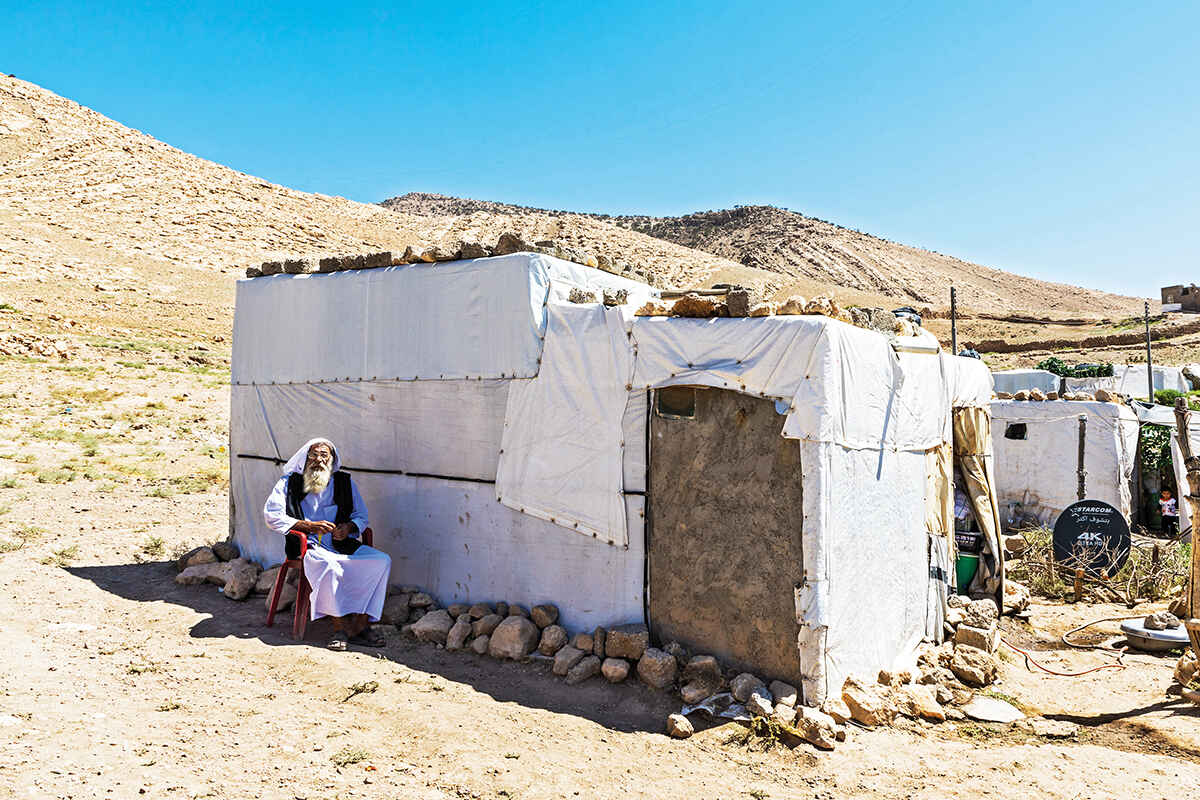
Iraqi Kurdistan, unlike the rest of Iraq or Syria, was previously considered relatively safe and stable. However, in recent years, growing problems have caused the semi-autonomous state to stumble
Report by Anna Pozzi, Photographs by Bruno Zanzottera
The ancient city of Erbil is a vast construction site, with concentric circles of ever-taller modern blocks stretching the capital of Iraqi Kurdistan out of all proportion. The 6,000-year-old city has been transformed into a version of Dubai nestled in the mountains of northern Iraq, lapped by desert and clinging onto a fragile peace.
At first sight, Erbil appears to be a booming success, with forests of skyscrapers, shopping malls and motorways that loop ever wider around the growing metropolis of nearly 900,000 people. It’s the capital of the nearest thing to a country of their own that the region’s 40 million Kurds have had in modern times. These mountain people have long lived in Western Asia, straddling what is today Turkey, Iran, Iraq and Syria. After the defeat of the Ottoman Empire in the First World War, a provision for a Kurdish state was made in the 1920 Treaty of Sevres. Three years later, that promise was broken, with most of the Kurdish people ending up within the boundaries of modern Turkey. Sporadic and often intense fighting – coupled with repression, persecution and even genocide – has been going on ever since. From the chaos of Saddam Hussein’s Iraq in the 1980s and the USA-led invasion in 2003, the mountainous northeast of Iraq emerged as a de facto independent state known as Iraqi Kurdistan, with its own flag and national anthem. Relations with Baghdad have often been fraught, but control over vast oil and gas reserves gave the embryonic Kurdish state significant autonomy.
The ‘country’ is, in fact, divided in two: the Erbil area is under the control of the Barzani family, represented by the ruling Kurdistan Democratic Party (KDP), while the Sulaymaniyah region in the east, near the border with Iran, is controlled by the Talabani clan and the Patriotic Union of Kurdistan (PUK). The rivalry between them led to civil war in 1994 and 1997. A fractious power-sharing regime has just barely kept a lid on armed conflict for the past 20 years. However, the car bomb assassination in October in Erbil of an intelligence officer who had defected from the PUK to the KDP has pushed tensions to near breaking point.
Oil and gas keep this volatile quasi-state afloat – the energy sector accounts for three quarters of GDP – while also fuelling the bitter rivalry between the factions. Plans to expand one of the region’s biggest gas fields, which is in PUK territory, have stalled, damaging hopes for the start of much-needed exports to Europe and heightening the sense of unease in the region. Some commentators suggest that the PUK is on the verge of splitting and setting up its own government in Sulaimaniya.
The vast wealth generated by hydrocarbons, particularly during the peak oil prices of the first decade of this century, was used to fund the speculative building boom in Erbil. It also had another, less obvious distorting effect on the country – rather than being invested in building sustainable industries and agriculture, it was used to fund a ballooning civil service based on patronage and corruption. Iraqi Kurdistan has more people employed by the state than any country bar Cuba – about 68 per cent of the workforce. Both ruling parties used the wealth to support their loyalists with generous wages for non-productive jobs.
While this didn’t matter so much during the heyday of high oil prices, it has had a devastating impact since they plummeted in 2014. The government can’t afford to pay salaries and social benefits, and government debt has rocketed to more than US$28 billion. Many see this as one of the main drivers leading young people from Iraqi Kurdistan to join the droves of migrants trying to enter Europe.

To compound the problem, while many of the country’s young have fled in search of work and a better future, Iraqi Kurdistan is still home to many of the region’s displaced people.
The UN’s International Organisation for Migration believes that it accommodates 870,000 long-term refugees who escaped first the horrors of the collapse of Iraq following the US-led invasion and then the bloody onslaught of the rise of Islamic State (ISIS) just to the west of the fledgling state. At least 250,000 more recently displaced people fleeing the conflict in Syria must be added to that overwhelming number.
‘In 2015–16, the number of refugees had reached 1.5 million out of a population of just over five million,’ explained Miriam Ambrosini, country representative of the NGO Terre des Hommes-Italy, which has been present in Iraqi Kurdistan since 2003. The NGO operates in several settlements, including Hasansham U3, an expanse of tents worn down by time and weather where 1,300 families (5,800 people in all), mostly women and children, struggle to survive.
‘They are 90 per cent Arabs who have come from Mosul to escape the advance of ISIS,’ she explained. ‘Many of the first influx did return to their places of origin, but many others no longer have the chance to do so. They remain here as if suspended.’
The Hasansham U3 camp is in a no man’s land, beyond the checkpoint of Iraqi Kurdistan and before that of Federal Iraq. The camp is controlled by the Peshmerga – the military force of Iraqi Kurdistan responsible for enforcing its borders and sovereignty.

Only a few NGOs are willing to work in this zone. ‘We are the only organisation working with children in this camp, where we offer non-formal education, psychological support and parental training,’ said Terre des Hommes-Italy project manager Ali Sahil. In some brightly decorated tents, they’ve created a space for the youngest children to play in, and in another large tent on the edge of the camp, activities are organised for adolescents and young people. The children and young people are stuck in the camp, often without documents and without prospects.
‘Better here than outside,’ Habib told us. He is 15 years old and has lived in the camp with his family for six years. ‘Our house was destroyed and there is still no security in our village.’
Fatima’s family also has no place to return to and she doesn’t want to leave the camp. Hugging her children, she said: ‘To go where? Here at least, they can go to school and there are organisations that guarantee support. I participate in the parental training programme myself and can get psychological support.’
Sitting with Fatima was her husband, who remained mute, his gaze downcast.
Many of the women are alone. ‘They are the ones with the most difficulties,’ Muhannad Edris, a Terre des Hommes-Italy project coordinator, himself a refugee from Syria, told us.

Many of the women are alone. ‘They are the ones with the most difficulties,’ Muhannad Edris, a Terre des Hommes-Italy project coordinator, himself a refugee from Syria, told us.
The subject is sensitive. Aid workers speak about it with great discretion but also with great concern. In the camp, there are women whom ISIS militiamen raped. The staff told us about one who kept her pregnancy a secret and was helped to give birth but wanted to abandon her child; the shame was too great. After a long dialogue with the family, the relatives agreed to take them both back. Others had been forced to marry Islamic State fighters and have had children whose paternity they don’t declare. These children have no documents and have difficulty enrolling in school. The staff also told us about child brides, who are taken as wives at a young age, made pregnant, and then abandoned.

In another camp in the northwest of Iraqi Kurdistan near the small town of Shariya, the conditions are even more desperate. Since 2014, the town of 10,000 inhabitants has been hosting a tented camp of more than 13,000 displaced Yazidis, with a further 17,000 of the ethno-religious group scattered in nearby abandoned villages. The Yazidis are in a highly vulnerable condition; many suffer acute depression and other mental disorders. Jilan, a Yazidi who works for the Jesuit Refugee Service (JRS), couldn’t hold back her tears as she told us of yet another atrocity. A father was beheaded in front of his wife and his six-year-old daughter, who was then raped and killed. This didn’t happen at the height of the ISIS horror in 2014, when its forces advanced on the Sinjar district determined to eradicate the Yazidis, but last August.
‘It is a genocide without end,’ said Jilan. ‘We are a people without land, without peace, without a future.’
Father Joseph Cassar, from Malta, who had been in charge of JRS for six years and a few days before we met him, had witnessed the exhumation of scores of corpses in a nearby mass grave, said: ‘They are the living testimony of a deep wound inflicted on humanity.’

He spoke almost in a whisper – as if out of modesty and respect – when he told us about the past and present horrors suffered by the Yazidis, a minority of about 600,000 people who practise an ancient monotheistic religion. They have been persecuted throughout the ages. The genocide in the Sinjar district in 2014 resulted in the deaths of 5,000 men, the abduction and enslavement of 7,000 women, the sale of thousands of children and the displacement of almost 200,000 people. Even today, more than 2,700 are unaccounted for. While the camp and surrounding area offer them sanctuary, it offers no escape route or solutions. The town is overrun with tents, as are the villages nestled against the mountain, which were evacuated when Saddam Hussein’s troops turned on the Yazidis back in the 1980s. The original inhabitants had begun to rebuild some homes when the waves of people fleeing the ISIS terror started to arrive. A very old man told us: ‘I arrived in 2014 with my whole family. And I’m still here.’
He showed us his tent. It had been reinforced with a small wall. In summer, temperatures exceed 50°C and in winter, it’s freezing. ‘Life is difficult; we are far from our homes, our land. We have left everything. We have nothing here,’ he whispered, with a look of desolation that words can’t describe.
Then, an elderly woman flashed a smile and offered us some tea. Even those who have virtually nothing here always have a cup of tea for the guest who comes from afar.
‘After more than eight years, almost nothing has changed,’ Firas Dakhil Sulaiman, a psychotherapist and director of the mental health sector of JRS told us. Thousands of people are suspended in a precarious present with a growing certainty that they’ve been abandoned and have no future. Humanitarian aid is drying up – more recent conflicts attract attention and revenue, the impression that Iraqi Kurdistan is stable and prosperous and the intractable nature of the problems conspire to make these refugees feel forgotten.

‘Our work focuses mainly on the education and protection of the most vulnerable through cash and food assistance, family visits and, above all, psychological support,’ Firas told us. ‘We follow about 800 cases, many of depression and post-traumatic stress – many people are at risk of suicide’.
As he was talking, he received an urgent call. A young pregnant woman had tried to take her own life with a drug overdose. Firas rushed off with his colleagues to drive the woman to the hospital in Duhok, some 15 kilometres away.
‘This is not the first time this has happened,’ he said on his return. ‘It happens especially with women who have often suffered violence and now have fewer opportunities than the men. It’s a challenge, he admits, to work in such an environment. ‘Sometimes we have the impression that we are making a few small steps forward, then events like this happen that force us to start all over again.’
Firas, himself a Yazidi, shares the traumatic family history of his patients. When Islamic State moved on Sinjar, his family decided to leave. ‘We crammed 13 of us into the car, but my father was so shocked that he couldn’t drive,’ he explained. ‘So we had to find someone else to do it for him.’ After hiding in the mountains, they managed to reach Shariya. He continued his harrowing story after showing us a gruesome image he keeps on his phone. ‘Two weeks later, my uncle was killed and beheaded because he refused to convert to Islam. In the end, we are Yazidis, we are Kafirs, we are infidels, we are nothing.’
‘It is not always easy to be brave,’ Jilan told us in another conversation. ‘Especially when you encounter stories of women or young girls who have suffered unspeakable horrors, or families with disabled children.’
She took us to another tent to meet a grandmother clutching a very frail disabled 11-year-old boy. ‘I defended him with my body when we ran away,’ the old woman told us. ‘But I am old now.’
The grandmother introduced us to the clearly very sick child’s mother. ‘He doesn’t want to eat anymore,’ whispered the distraught woman. She said he doesn’t get any medication for epilepsy because it costs too much, and his father lost his labouring job after breaking his arm. Jilan and Firas promised to return. The grandmother said farewell by kissing them softly on their foreheads as if they were her children.
Another psychologist, Pisyar Darman Khalaf, told us that more and more children are exhibiting mental illnesses. ‘Some of them were born and raised here, a whole life in a tent,’ he said. ‘They have no sense of belonging to a community; they have no identity.’
Often, they don’t even have papers. The charity works hard to persuade the camp’s residents to renew their identity cards. ‘Without them they do not exist, they are invisible,’ Khalaf said. ‘We must prevent that. The Yazidis must not disappear!’




